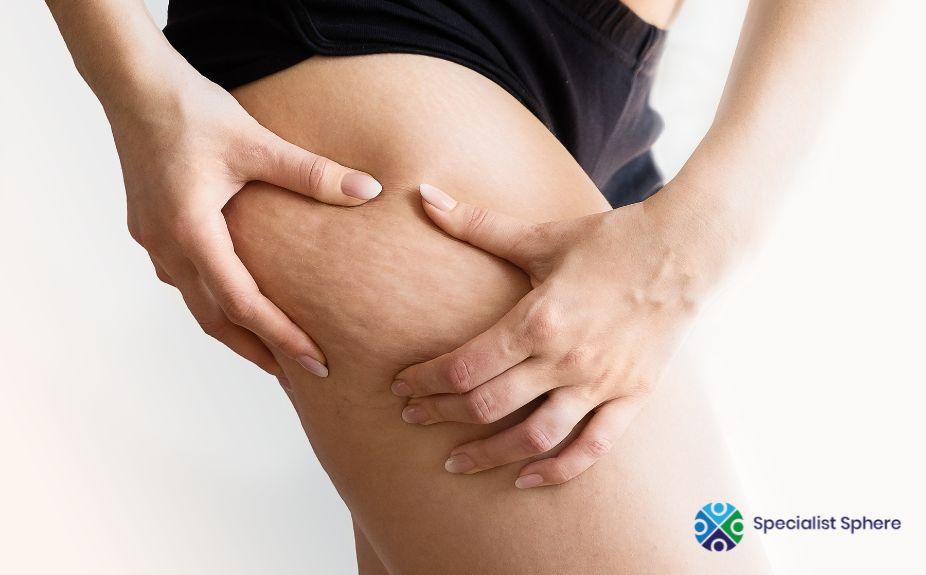Stretch marks are a natural part of life for many people, often appearing as a result of rapid changes in weight, growth spurts, pregnancy, or bodybuilding. These streaks, which can be red, purple, or white, are caused by the stretching or shrinking of the skin, leading to damage in the underlying collagen and elastin fibers. While they are harmless, many people seek effective ways to reduce their appearance.
RF microneedling is a leading solution for stretch mark removal and reduction. This treatment combines two powerful techniques—microneedling and radiofrequency (RF) energy—to stimulate the skin’s natural healing process and rebuild the essential proteins that give your skin its structure. This guide explains exactly how this treatment works, what the process involves, and what results you can expect.
How Does RF Microneedling Work for Stretch Marks?
RF microneedling works by addressing the root cause of stretch marks: damaged collagen and elastin. By combining two therapies, it creates a powerful synergy for skin repair.
- Microneedling: Tiny, sterile needles create controlled micro-injuries in the skin. These channels trigger your body’s natural wound-healing response, prompting it to produce new collagen and elastin fibers.
- Radiofrequency (RF) Energy: Simultaneously, RF energy is delivered deep into the dermis (the layer of skin where collagen is produced). This thermal energy heats the tissue, further stimulating a significant boost in collagen and elastin production.
Together, these two mechanisms work to restructure and strengthen the skin from within. The new collagen helps to smooth the texture of the skin, making the stretch marks less defined, while elastin production improves the skin’s overall flexibility and tone.
FAQs About the RF Microneedling Treatment Process
Q: What happens during a consultation for stretch mark removal?
A: The process begins with a consultation and skin assessment. A qualified practitioner will examine the specific characteristics of your stretch marks, including their color, depth, and location. They will then determine if you are a suitable candidate for RF microneedling and discuss a personalized treatment plan, including the number of sessions likely needed to achieve your desired results.
Q: How should I prepare for my RF microneedling session?
A: Before your treatment, it’s crucial to prepare your skin to maximize results and minimize risk. Avoid prolonged sun exposure or tanning in the days leading up to your appointment. You should also stop using any products with strong exfoliants or active ingredients like retinoids a few days beforehand. Your practitioner will provide specific pre-treatment instructions, which you should follow carefully.
Q: What does the RF microneedling procedure feel like?
A: Before the procedure begins, the treatment area is cleansed, and a topical anesthetic cream is applied to ensure your comfort. During the treatment, a specialized device is passed over the stretch marks. You may feel a slight pressure from the needles and a warm sensation from the RF energy. The procedure typically lasts up to 60 minutes, depending on the size of the area being treated.
What to Expect After Your Treatment
Short-Term Results & Recovery
Immediately after the procedure, it’s normal to experience some redness and mild swelling, similar to a light sunburn. This usually subsides within a few hours. Your skin may also feel warm and slightly rough to the touch for a few days as it begins to heal. These are all signs that your skin’s natural repair process is underway.
Long-Term Results
The true benefits of RF microneedling for stretch marks develop gradually. As new collagen and elastin are produced, you will notice a visible improvement in your skin’s texture and elasticity. The color and texture of the stretch marks will begin to fade, blending more seamlessly with the surrounding skin. Optimal results are seen after a series of treatments, with progressive improvement over several months.
Important Questions About RF Microneedling
Q: How many RF microneedling sessions are needed for stretch marks?
A: The number of sessions required varies for each individual. Factors like the age and severity of your stretch marks, your skin type, and your body’s response to the treatment all play a role. A typical treatment plan involves 3 to 6 sessions, spaced 4 to 6 weeks apart. This spacing allows the skin to fully heal and new collagen to develop between appointments.
Q: Who is a good candidate for this treatment?
A: Most individuals with stretch marks are suitable candidates for RF microneedling. However, it may not be recommended for those with active skin infections, open wounds, or certain medical conditions that affect healing. It is not advised during pregnancy. If you have an implanted electronic device, such as a pacemaker, you should not undergo RF-based treatments. A consultation with a qualified professional is the best way to determine your suitability.
Q: What is the best aftercare for RF microneedling?
A: Proper aftercare is essential for achieving the best results and preventing complications.
- Keep the area clean: Avoid touching the treated area and keep it clean to prevent infection.
- Moisturize: Use a gentle, hydrating moisturizer to support the healing process.
- Protect from the sun: Your skin will be more sensitive to UV exposure. Apply a broad-spectrum sunscreen daily and avoid direct sun exposure.
- Avoid harsh products: Refrain from using strong exfoliants, retinoids, or other active skincare ingredients until your skin has fully healed.
Conclusion
RF microneedling offers a powerful, non-surgical solution for significantly reducing the appearance of stretch marks. By harnessing the body’s natural healing and collagen-building processes, this treatment can restore skin texture and help you feel more confident in your own skin. To find out if this is the right option for you, a consultation with a certified practitioner is the best first step.
Ready to learn more about RF microneedling for stretch mark reduction? Schedule a consultation today to discuss a personalized treatment plan.


